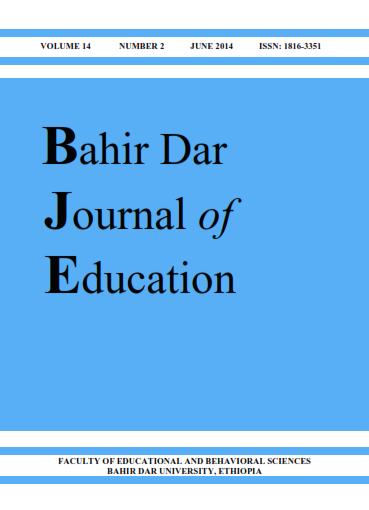Status of Gender Parity in the Ethiopian General Education
Abstract
The main purpose of this study is to critically examine as to how the education sector is moving towards gender parity in primary and secondary education in terms of school enrollment related issues, male-female teacher ratio, gender sensitiveness of facilities, and study barriers for achieving gender parity. Document review was used to collect data from official documents including the six years' educational statistics annual abstracts, the recent Education for All global monitoring report, the Education Sector Development Programs and different research reports. The documents were mainly examined by focusing on the four areas (parameters) listed above. The result indicated that there is a remarkable improvement in gender parity across the years in both primary and secondary schools in terms of female students’ enrolment. However, there are problems in dropout, repetition, and completion rates and different barriers are affecting girls' education that negatively influences the move towards achieving gender parity especially in secondary schools. Implications of the outcomes of the study for practice and research are described.References
Clarke, P. (2011). The status of girls’ education in Education for All Fast Track Initiative partner countries. Prospects, 41:479–490. DOI 10.1007/s11125-011-9214-6.
Delelegn, A. (2007). Intra-household gender-bias in child educational spending in rural Ethiopia: panel evidence. Ethiopian Journal of Economics, XVI, 2.
FDRE. (1994). Education and training policy. Addis Ababa: Berehanena Selam Printing Enterprise.
FDRE. (1995). The Ethiopian constitution, 1994. Addis Ababa, Birhan ena Selam Printing Press.
FDRE. (December, 2012). Assessing progress towards the Millennium Development Goals: Ethiopia MGDs report 2012. Retrieved on 12 th February 2014 from http://www.mofed.gov.et/English/Resources/Documents/Ethiopia_MDG_Report_2012.pdf .
Gorfu, M., and Demsse, A. (2007). Sexual violence against school girls in Jimma Zone: Prevalence, patterns, and consequences. Ethiopian Journal of Education and Science, Vol. 2 (2):11-37.
Jennings, M. (2011). Social assessment for the education sector, Ethiopia. Retrieved 7 December 2013, from http://www.nae.gov.et/download/safd.pdf
Lasonen, J., Kemppainen, R., and Raheem, K. (2005). Education and training in Ethiopia: An evaluation of approaching EFA goals. University of Jyväskylä. Institute for Educational Research. Working Papers 23. Retrieved on 11May, 2014, from https://ktl.jyu.fi/julkaisut/julkaisuluettelo/julkaisut/2005/f023-1.
Ministry of women’s affairs. (2006). National action plan for gender equality 2006-2010. Addis Ababa: Ministry of women’s affairs.
MoE. (2013). Education statistics annual abstract 2012/2013. Unpublished manuscript. Addis Ababa: Ministry of Education.
MoE. (2012). Education statistics annual abstract 2011/2012. Unpublished manuscript. Addis Ababa: Ministry of Education.
MoE and UNICEF. (2012). Study on situation of out of school children (OOSC) in Ethiopia. Retrieved from http://www.unicef.org/ethiopia/OSCStudyReport2012.pdf
MoE. (2011). Education statistics annual abstract 2010/2011. Unpublished manuscript. Addis Ababa: Ministry of Education.
MoE. (2010). Education Sector Development Program IV (ESDP IV). Addis Ababa: Ministry of Education.
MoE. (2010). Education statistics annual abstract 2009/2010. Unpublished manuscript. Addis Ababa: Ministry of Education.
MoE. (2009). Education statistics annual abstract 2008/2009. Unpublished manuscript. Addis Ababa: Ministry of Education.
MoE. (2008). Education statistics annual abstract 2007/2008. Unpublished manuscript. Addis Ababa: Ministry of Education.
Mulugeta, E. (2004). Swimming against the tide: educational problems and coping strategies of rural female students in Ethiopia. EASSRR, XX, 2.
Swedish Agency for development evaluation (2011). Gender equality in and through education: SADEV REPORT 2010:9. Retrieved on 19 December, 2013, from http://www.oecd.org/derec/sweden/48350382.pdf.
UNESCO Institute for Statistics. (2010). Global education digest 2010: comparing education statistics across the world. Retrieved 23 October 2013, from http://www.uis.unesco.org/Library/Documents/GED_2010_EN.pdf
UNESCO. (2014). EFA global monitoring report 2013/4: teaching and learning: achieving quality for all. Paris: UNESCO.
UNESCO. (2000). The Dakar framework for action: education for all: meeting our collective commitments. Retrieved on 21 March, 2014 from http://unesdoc.unesco.org/images/0012/001211/121147e.pdf.
Authors who publish with this journal agree to the following terms:
- Authors retain copyright and grant the journal right of first publication with the work simultaneously licensed under a Creative Commons Attribution License that allows others to share the work with an acknowledgement of the work's authorship and initial publication in this journal.
- Authors are able to enter into separate, additional contractual arrangements for the non-exclusive distribution of the journal's published version of the work (e.g., post it to an institutional repository or publish it in a book), with an acknowledgement of its initial publication in this journal.
- Authors are permitted and encouraged to post their work online (e.g., in institutional repositories or on their website) prior to and during the submission process, as it can lead to productive exchanges, as well as earlier and greater citation of published work (See The Effect of Open Access).

